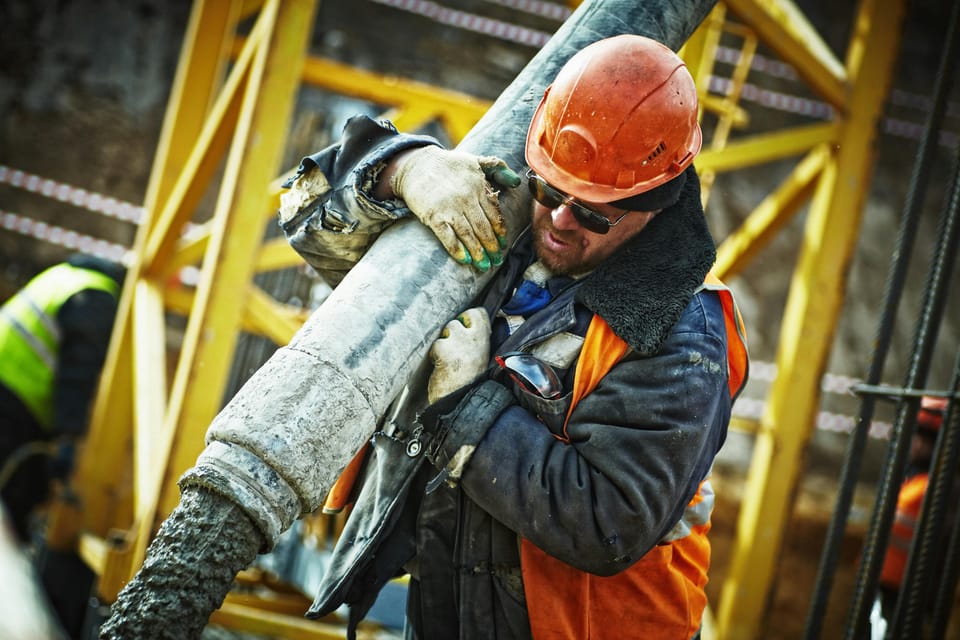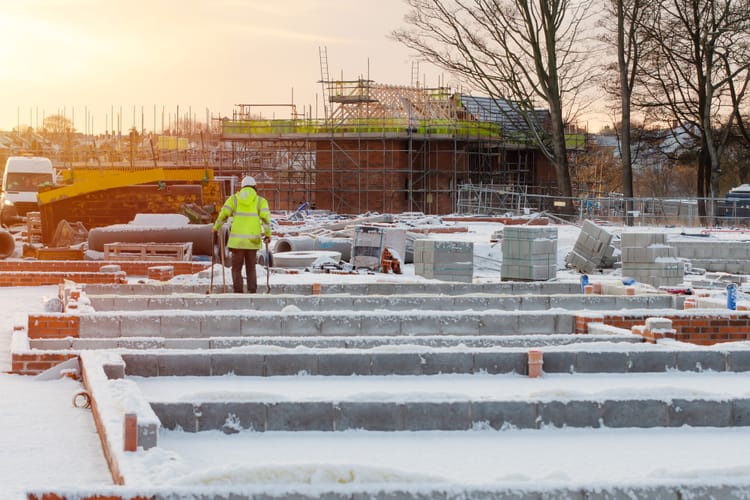Construction’s hottest challenges

When the heat rises, so do the challenges. This week, we break down the hidden costs of extreme weather on jobsite safety, productivity and project timelines. We also look at how new federal rules are making it even harder to keep crews staffed. Plus, a look at the colors and materials trending in high-end builds. And before you get back to the grind, don’t miss this incredible hybrid of sculpture and structure—a castle-inspired feat that might just change how you see sand.

>> And we’re walking… Join The Happy Urbanist as he points out what we’ve learned about form-based code from Seaside, Florida’s built environment.
>> It’s alive! Take a look at the innovations that turn building façades into vertical ecosystems.
>> That’s not what I meant! Find out what the colors in your logo say about your company.
>> Speaking of color… Meet Radiant Lilac and the other “loneliest” paint colors in the Sherwin-Williams archives.

Federal cuts put job training programs at risk
Preparing people for careers in construction is critical to withstanding the impact of ICE raids that worsen the ongoing labor shortage. Nonprofit workforce development organizations are vital to the cause. One of them is Hope Renovations, which has trained 159 tradespeople since 2020 and is on track to train 80 more this year.
Unfortunately, earlier this year, the organization's $713,000 grant from the federal Women in Apprenticeships and Non-Traditional Occupations initiative was withdrawn as part of the Department of Government Efficiency’s anti-DEI initiative, slashing a third of their budget. The nonprofit is running a fundraising campaign to try to cover the loss. And another blow may be in the offing, as the U.S. Labor Secretary and the president announced plans to shut down the Women’s Bureau entirely.
The Level spoke with Sarah Campbell, MSW, Hope Renovations' vice president of workforce development, about the organization’s work and role in the industry. -Margot Lester
How do organizations like yours make a difference to the industry?
The workforce shortage affects all kinds and sizes of construction businesses. Employers and training providers like us need to work together to fill the workforce gap. There are dozens of nonprofits across the country working to train the next generation of tradespeople. Some of them focus on women and gender minorities, like us, and some of them focus on youth or displaced workers, or workers re-entering the workforce from prison.
How did losing the grant impact your in-progress training programs?
Part of the grant funded subsidies to local employers to incentivize hiring short-term interns. Without the grant funding, we are no longer able to incentivize this internship program. Employers are losing out on the subsidy and on the opportunity to have low-risk labor to meet short-term and long-term needs.
What can contractors do to help?
These organizations need employer partners to succeed and meet our collective goal of a thriving construction industry. We are always looking to partner with local contractors for employment, education, exposure and funding. Hiring program grads is obvious, but there are less obvious ways to partner, such as hosting a job site tour to expose trainees to real-life trades in action, or to teach a module or speak to a class. These kinds of interactions also provide networking opportunities that give you exclusive access to trainees who may be a good fit for your organization in the future.
What else should we know?
Women make up only 5% of the hands-on craft positions. With more workers retiring out of the industry than entering it, recruiting women and gender-expansive individuals to fill the workforce shortage is smart business.
Are you a contractor with something to say? Email us to be considered for a future Spotlight!

The invisible cost of extreme heat
Extreme heat is a known danger to crew health and safety. It’s also a threat to your bottom line. New analysis from Swiss Re, the global insurance company, indicates that extreme heat is the number-one emerging risk for businesses and insurers. Yet most company owners don’t realize the atmospheric phenomenon’s financial impact. “With a clear trend to longer, hotter heat waves, it is important we shine a light on the true cost," Swiss Re Group Chief Economist Jérôme Haegeli said in a statement.
The most significant costs of heat are obscured because they’re counted in other categories. For example, injuries and illnesses caused by very high temperatures create costs related to lost work days, delays, additional subs and medical or workers’ comp claims. Heat can affect tools and equipment, making them more expensive to run or rendering them unusable at all—increasing fleet management spend and, again, potentially creating delays.
And that’s not all. In addition to how extreme heat ratchets up wildfires and drought risk, it also exacerbates subsidence (the sinking of surface soil). That could mean a higher likelihood of sinkholes and structural damage during construction, which prompts more delays, rework and fines. Speaking of fines, if you don’t provide enough water or cooling breaks, you could be found liable for employees' health issues, which generates legals fees and possible damages.
Why it matters: July is typically the hottest and most humid month. That means now is a good time to review the CDC’s resources for discussing potential heat harms with employees and to reassess your heat risk with your property and liability insurers. Together, you can develop mitigation strategies aimed at reducing threats to your employees, your projects and your company’s health. (Bloomberg Green)
New home buyers looking for less
Buyers' tastes may turning away from large lots and plots to escape higher property taxes and maintenance demands. Cynthia Quade of Signature ONE Realty Group says many of her clients are drawn to one-third to one-quarter-acre parcels rather than the once-popular half-acre size. And she sees growing interest in “twin homes,” single-family dwellings that have a common wall but are on individual plots. Belmonte Builders has bought into the trend, constructing 80 twin homes at a development in upstate New York.
Why it matters: In addition to meeting changing customer demand, less acreage and square footage can keep land acquisition and construction costs down. Talk to brokers in your area to find out if they’re seeing these trends and to uncover other opportunities to capitalize on emerging interests. (Times Union)
A higher tax on jobsite snacks?
With all the other news coming out of Congress, you may have missed an upcoming change to a business tax deduction that could impact your company’s tax return and culture. A 2017 tax law allowed 100% deductions for employer-provided food and beverages. Some tax experts interpret that to cover coffee, snacks and team lunches, too. That law will sunset in 2026, slicing the amount by half, meaning this fringe benefit will cost more.
Why it matters: Corporate culture experts say little things like free coffee and snacks positively affect morale and productivity. As simple as they are, they show you care. And if you choose healthy options, you also support employee well-being. Shared breaks and lunches also build camaraderie and team spirit. Another upside: when you provide snacks, employees have less reason to step away from the site, keeping breaks shorter and productivity higher. (MoneyTalksNews.com)

>> Site Safety: Hard hats are due for an upgrade
>> Remodeling Reccs: Renos make aging in place possible
>> Insurance Insights: How to keep workers’ comp costs in check
>> Keeping Cool: The heated debate over a new roofing technology

“In the next five years, 75% of commercial and retail facilities that have smart building systems or smart building controls will be participating in some form of demand response.” — Adam Scarsella, director of sales for Voltus
Scarsella made that prediction on a recent edition of the Cool Air, Hot Takes podcast, when he joined hosts Charlie Jelen and Dan Gentry to discuss demand response programs. In these initiatives, building systems like heating, cooling and lighting are dialed back or shut off in times of high demand or emissions to reduce power pulled off the grid. In return, property owners are compensated with cash payments or rate reductions. Listen here.
Thanks for reading today's edition! You can reach the newsletter team at thelevel@mynewsletter.co. We enjoy hearing from you.
Interested in advertising? Email us at newslettersales@mvfglobal.com
Was this email forwarded to you? Sign up here to get this newsletter once a week.
The Level is written by Margot Lester and edited by Bianca Prieto.





